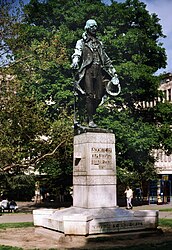Monument to Dositej Obradović
| Monument to Dositej Obradovic | |
|---|---|
 |
|
| Data | |
| place | Belgrade , Serbia |
| Construction year | 1914 |
The monument to Dositej Obradović , the great Serbian enlightener, is located in the Belgrade Academic Park , together with the monuments of the Serbian scientists Josif Pančić and Jovan Cvijić in the immediate vicinity of the faculty building of the University of Belgrade .
history
The monument was erected at the instigation of Jovan Skerlić , who adored Dositej Obradović, and the Serbian Literary Cooperative . The idea of erecting the monument, which arose in the mid-19th century, was revived in 1909 on the 100th anniversary of Dositej Obradović's death in 1911. An anniversary committee headed by Stojan Novaković and Jovan Skerlić planned the erection of a monument in addition to a series of events. The Belgrade municipality supported the project, collected part of the financial means and launched a tender for the elaboration of the monument among all Yugoslav artists. The monument should be a life-size figure of Dositej.
The tendering committee was made up of: Ljuba Davidović , the chairman of the Belgrade municipality, Bogdan Popović , Andra Stevanović and Bogdan Gavrilović, the professors at the university, Vladimir R. Petković, the deputy director of the Folk Museum and Leger, the head of the municipal builders. Twelve artists submitted models, which were exhibited in the elementary school near the cathedral church (today the elementary school "Kralj Petar Prvi" (King Petar the First) ). The committee selected the models by Rudolf Valdec, Toma Rosandić and Simeon Roksandić for the first three prizes. First place went to the work of Rudolf Valdec, who was also entrusted with the work on the monument. It was said: “From Dositej one has the idea of a traveler who is boldly driven forward by a supernatural force that has been awakened in him. His eyes are fixed on an exalted goal to which his legs are supposed to bring him. The books under his arm and the quill in his hand indicate his noble mission. You can feel that the path he is paving leads to fame and eternity ”.
The ceremonial unveiling took place on May 27th (June 9th after the new one) 1914 “in one of the most beautiful places in Belgrade”. After suggestions "on the reconstructed Terazije Square" or on the square on Makedonska ulica were quickly rejected, the monument was placed on the square in front of the hotel "Srpska kruna" (Serbian crown) (today the library of the city of Belgrade) as a counterpart to the Monument to Karadjordje that was unveiled a year earlier at the end of Kalemegdan's main avenue. Busts of many famous Serbs were placed along this avenue. In this way Dositej was brought into direct contact with the leader of the First Serbian Uprising.
The sculpture was placed on a high rectangular pedestal, on the front of which the following dedication was carved: “For Dositej Obradović, the grateful Serbian people” and on the back the author's motto, which was taken from the letter to Haralampi: “I will for the To write the spirit, the heart and the essence of man and, for the brothers of Serbia, whatever law and belief they follow. ”Dositej was depicted in motion, with hat, books and a stick in hand. On the lower part of his pedestal are his words: "He learns while walking, he looks down the centuries!"
Until the end of the 1930s, the monument was located in the original place in front of the “Srpska Kruna” hotel until it was moved to the Academic Park, which was newly established in place of the former Great Market, as a counterpart to the monument to the scientist Josif Pančić . The monument to Dositej Obradović was declared a cultural monument in 1967 (decision of the Institute for the Protection of Cultural Monuments of the City of Belgrade, No. 1031/1 of December 20, 1967).
Individual evidence
- ↑ SGBogunović, Studentski trg (Student Square), The Architectural lexicon of Belgrade of XIX i XX century, the architecture (I), Belgrade 2005, the 400th
- ↑ Serbian Literature Cooperative October 9, 2013. Archive link ( Memento of the original from November 5, 2011 in the Internet Archive ) Info: The archive link was inserted automatically and has not yet been checked. Please check the original and archive link according to the instructions and then remove this notice.
- ↑ Belgrade Heritage, Catalog of Immovable Cultural Assets, Institute for the Protection of Cultural Monuments of the City of Belgrade, October 9, 2013. Archive link ( Memento of the original from November 5, 2011 in the Internet Archive ) Info: The archive link has been inserted automatically and has not yet been checked. Please check the original and archive link according to the instructions and then remove this notice.
- ↑ М.B. Protić, Art on Yugoslav soil Sculpture of the XX Century, Belgrade, Zagreb, Mostar 1982.
- ↑ Nova iskra magazine (The new spark )
- ^ "Politika" (daily newspaper), May 28, 1914., page. 2-3. The digital public library of the Republic of Serbia.rs (access October 17, 2015) [1]
- ^ The Library of the City of Belgrade [2] , accessed October 10, 2013
- ↑ М. Timotijević, The Hero of the Pen as a Traveler: Typological The Genesis of Public National Monuments and the Valdec Sculpture by Dositej Obradović, The Heritage, III, Belgrade, 2001, 46.
literature
- Documentation ZZSKGB - Acts of the cultural monument.
- M. Timotijević, The hero of the quill as a traveler: typological genesis of public national monuments and the Valdec sculpture by Dositej Obradović, The Heritage, III, Belgrade, 2001, 39–56.
- S. Mihajlov, The Monument to Dositej Obradović, Catalog of Cultural Monuments, Belgrade 2011.
- http://beogradskonasledje.rs/kd/zavod/stari_grad/spomenik_dositeju_obradovicu
- http://beogradskonasledje.rs/wp-content/uploads/2012/06/k4/dositej.pdf



